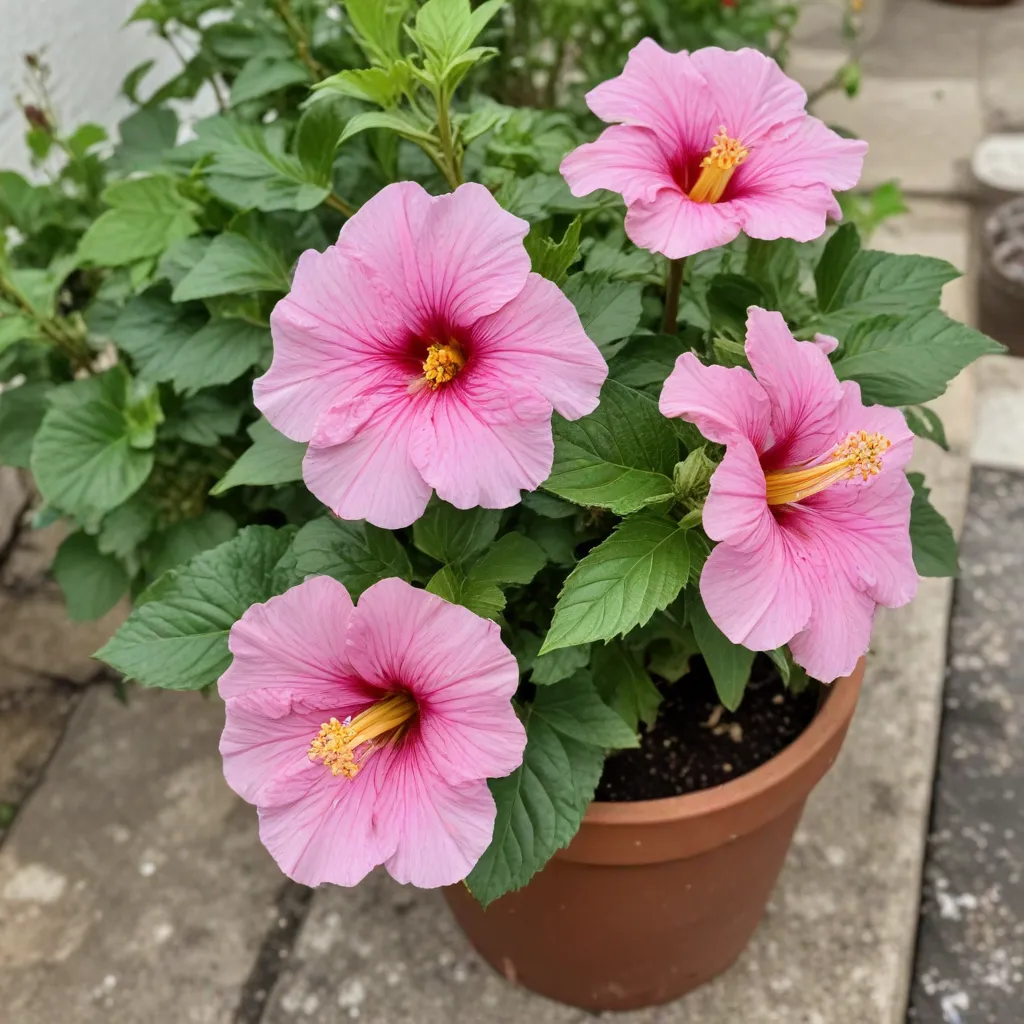
As the summer sun beats relentlessly on our Western Algarve retreat, our garden remains a vibrant oasis, thanks to the resilient hibiscus plants that thrive in their potted homes. As a hospitality and wine expert for the Wine Garden Inn, I’m delighted to share our latest garden adventures, from cultivating these tropical beauties to the charming musings of our guest, Piglet, as she explores the wonders of Portugal.
Growing Hibiscuses in Pots
One of the true joys of container gardening is the ability to introduce splashes of color and interest to areas where in-ground planting is impractical. For us, hibiscus plants have become the stars of this portable botanical display, offering a lush, eye-catching presence that persists throughout the year.
Ideal Pot Sizes and Materials
When selecting pots for your hibiscus, opt for containers that are at least 12 inches in diameter and depth. This allows the plant’s robust root system ample room to spread and support the vigorous growth above ground. Terracotta or ceramic pots work well, as their porous nature encourages proper drainage and air circulation around the roots.
Soil Requirements for Hibiscus
Hibiscus thrive in a well-draining, nutrient-rich potting mix. Incorporate compost or aged manure to provide a steady supply of organic matter and soil nutrients. Avoid heavy, clay-based soils, as hibiscus are susceptible to root rot in overly wet conditions.
Watering and Feeding Potted Hibiscus
Consistent moisture is key for hibiscus grown in containers. Water the plants when the top inch of soil becomes dry, taking care not to let them sit in waterlogged soil. Supplement with a balanced, water-soluble fertilizer every two to three weeks during the growing season to fuel their vibrant blooms and lush foliage.
Hibiscus Plant Varieties
Common Garden Hibiscus Types
The familiar Hibiscus rosa-sinensis, or Chinese hibiscus, is a common sight in many gardens, both in the ground and in pots. Its large, showy flowers come in a rainbow of colors, from bold reds and oranges to delicate pinks and whites.
Tropical Hibiscus Cultivars
For container gardening, the tropical hibiscus varieties, such as Hibiscus coccineus and Hibiscus schizopetalus, are excellent choices. These types are often more compact and better suited to the confines of a pot, while still delivering an impressive floral display.
Selecting Suitable Hibiscus
When choosing hibiscus for your pots, consider the mature size of the plant, its sun and water requirements, and the overall aesthetic you’re aiming to create. Some varieties, like the Hibiscus moscheutos, are exceptionally cold-hardy and can even withstand light frosts, making them a versatile option for gardeners in temperate climates.
Hibiscus Cultivation Challenges
Sun Exposure and Temperature
Hibiscus are sun-loving plants, thriving in locations that receive at least six hours of direct sunlight per day. In hot climates like ours, afternoon shade can help prevent leaf scorch and wilt. Protect potted hibiscus from extreme cold, as they are generally sensitive to frost and freezing temperatures.
Pests and Diseases to Monitor
Vigilance is required when growing hibiscus in containers, as they can be magnets for common garden pests like aphids, mealybugs, and spider mites. Regularly inspect the plants, and address any infestations quickly with a gentle, organic insecticidal soap or a systemic insecticide applied to the soil.
Overwintering Potted Hibiscus
In cooler regions, potted hibiscus may need to be brought indoors or provided with extra protection during the winter months. Reduce watering, and consider moving the plants to a sunny, sheltered spot to hibernate until spring’s return.
Gardening in Different Climates
Gardening in Warm Regions
Our Mediterranean-style climate in the Western Algarve is well-suited for growing hibiscus year-round in containers. The mild winters and abundant sunshine allow these tropical plants to thrive with minimal fuss, providing us with a continuous display of vibrant blooms.
Gardening in Temperate Climates
Gardeners in more temperate regions may need to carefully select hibiscus varieties and employ strategies like overwintering to ensure their plants survive the colder months. With some extra effort, however, these stunning flowers can still be enjoyed in pots, adding a touch of the exotic to any outdoor space.
Piglet in Portugal
Piglet’s Travel Adventures
As our guest, Piglet, has discovered, the Western Algarve offers a rich tapestry of experiences for the discerning traveler. From exploring the region’s charming villages to savoring the local cuisine and wine, Piglet’s adventures have provided us with a delightful outsider’s perspective on life in our little corner of Portugal.
Piglet’s Gardening Observations
Piglet’s passion for gardening has not gone unnoticed, and she has been captivated by the vibrant hibiscus plants that grace our Wine Garden Inn grounds. In her blog post, Piglet shares her own experiences with cultivating these tropical beauties in pots, offering valuable insights and tips for fellow enthusiasts.
Piglet’s Portugal Blog Posts
Throughout her stay, Piglet has documented her discoveries on her blog, Piglet in Portugal. From her August Garden Diary to her exploration of container gardening in September, her vivid accounts and stunning photography have captivated our readers, inviting them to experience the joy of gardening in Portugal alongside her.
As the summer heat continues to bake our little slice of paradise, our hibiscus plants remain steadfast, their vibrant blooms a testament to the beauty that can thrive even in the most challenging conditions. With Piglet’s keen eye for detail and our own expertise in hospitality and wine, we invite you to venture with us through the wonder of our August garden diary and beyond, as we celebrate the endless delights of life in the Western Algarve.
